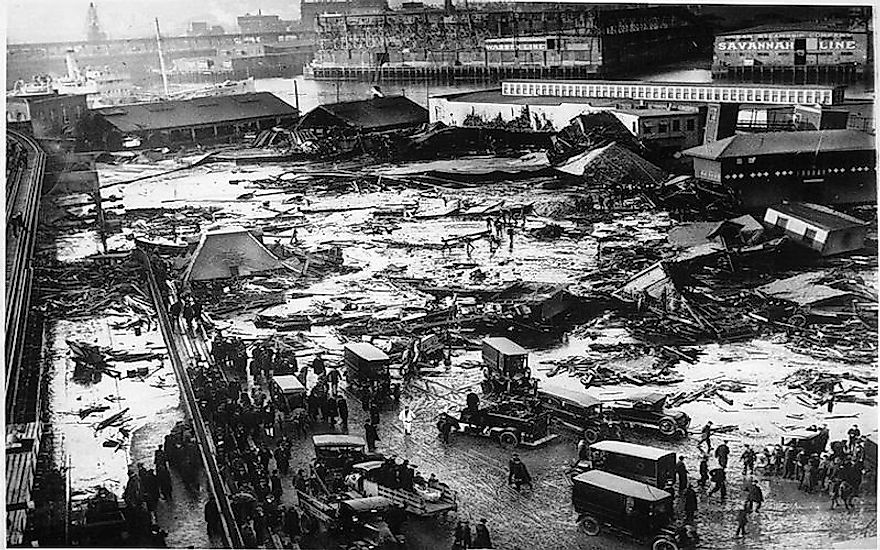What Was The Great Molasses Flood Of Boston?

Boston suffered one of history’s strangest disasters on January 15, 1919, whenthe Great Molasses flood tore through the city’s North End. Its effects could be felt for several months. Molasses is a sweet ingredient that has several uses including the manufacturing of alcohol. The Purity Distilling Company built a large molasses tank in North End, Boston, to supply its alcohol manufacturing plant. The tank was 50-feet tall and was capable of holding over 2 million gallons. It was nearly full on the on the day of disaster thanks to the infusion of 2.3 million gallons of molasses from Puerto Rico.
The Nature Of The Flood
The Great Molasses Flood occurred on January 25, 1919, at around 12:40hrs. The cool afternoon was broken by sounds of breaking metallic material. Before the residents could register what was happening, the 50-feet molasses tank ripped open unleashing a wave of molasses which was 25 feet high at its peak. The sticky liquid wave was moving at a speed of 35 mph and sweeping everything on its way. The wave damaged the adjacent Boston Elevated Railways structures and crushed the nearby building. Some of the blocks were flooded to about 2 feet high. The molasses cooled and thickened faster as it moved through the city of Boston hampering the rescue effort. The molasses flood also swept away people, trucks, and animals. The Engine 32 firehouse was knocked down its foundation collapsing its second story into the first. Over 150 people were injured with 21 people and several horses killed in flood. The total damage in the city of Boston was estimated to about $100 million.
Cause Of The Great Molasses Flood
The cause of the Great Molasses Flood was initially blamed on the anarchists by the US Industrial Alcohol Company. The company claimed that its alcohol was used by the government for its munitions and that the anarchist may have played a role in the destruction of the tank. Another theory suggested that the content of the tank may have fermented leading to an explosion which caused the flood. The fermentation may have produced carbon dioxide which raised the temperature over the period. However, investigations found that the real explosion was caused by the shoddy construction of the plant. The tank was hurriedly constructed to beat prohibition in the US which was ratified a day after the disaster. The necessary safety tests were ignored during the construction of the tank. The steel used in the construction was thinner than the required thickness and the tank had leaked since its construction. Arthur Jell who oversaw the construction of the tank was neither an engineer nor an architect and could not read the blueprint.
The Rescue Effort And Aftermath
The police and firefighters were mobilized to the accident scene within minutes. About 116 cadets were the first to get to the scene. They struggled to wade through the thick molasses flood plucking survivors. The Red Cross nurses and several doctors made makeshift hospitals in the nearby buildings to tend to the injured. The search and rescue went on for four days with the dead glazed over molasses making it difficult to recognize them. One of the victim’s body, Cesar Nicolo, was found four months after the incidence. The residents were engaged in a lawsuit battle with the US IA with the company paying $7,000 to each victim. The place where the plant was constructed is currently a recreational complex named Langone Park.











